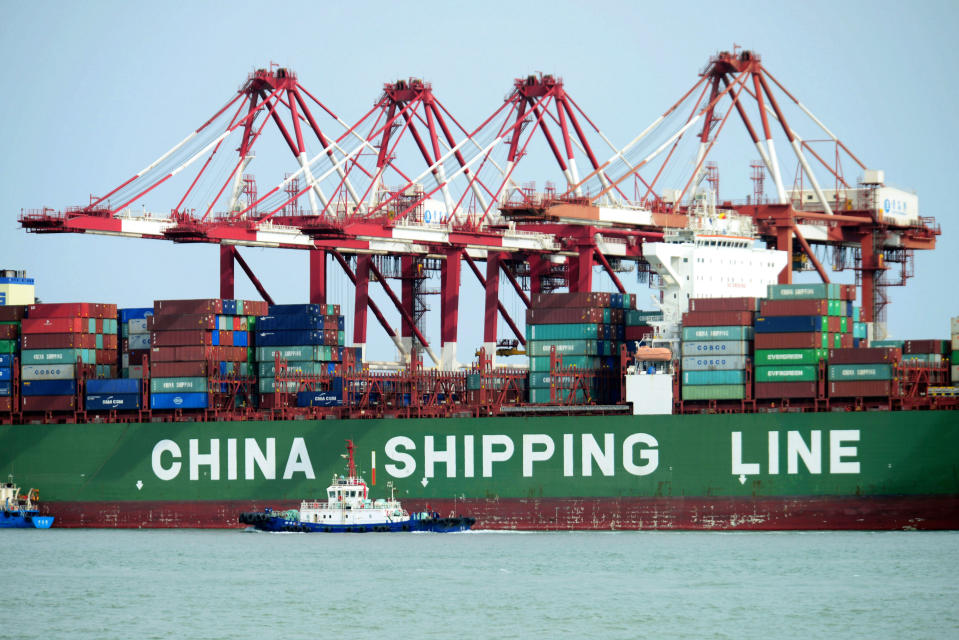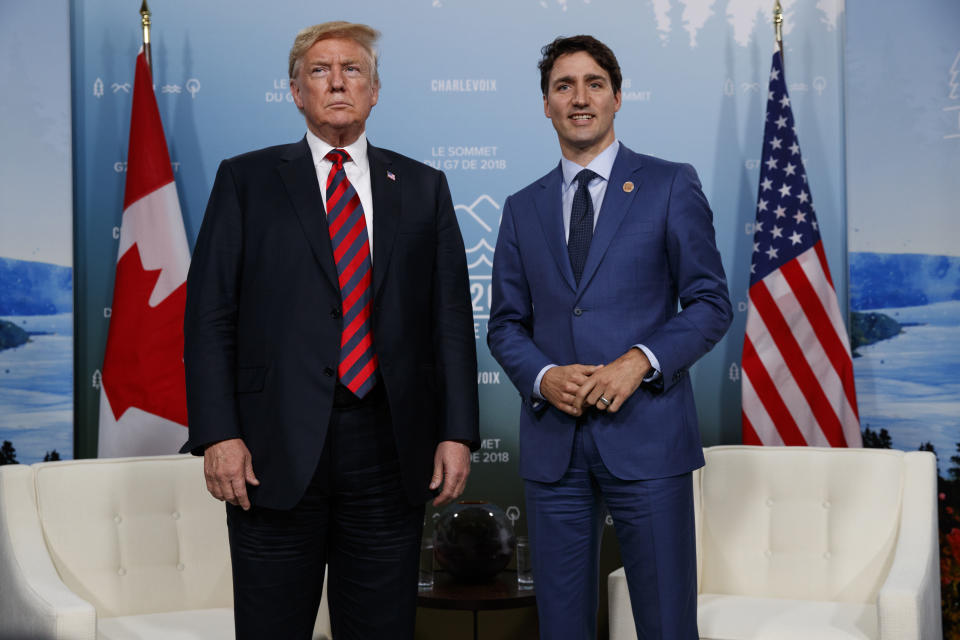6 ways to fix trade without the Trump tariffs
President Trump is right: Some US trading partners cheat. But getting better trade deals doesn’t require the damaging tariffs and other protectionist measures Trump is rolling out. There are better ways.
Trump has spent 2018 haranguing trade partners and imposing tariffs that are beginning to cause economic harm. So far, Trump has imposed tariffs ranging from 10% to 50% on about $107 billion worth of imports. He has threatened additional tariffs on another $408 billion worth of imports. China, Europe and Canada have announced retaliatory tariffs on US imports in response, with no sign of a break in the escalation.
Trade angst has depressed the stock market, which is essentially flat for the year even though the economy seems to be strengthening. Some companies are beginning to struggle with higher costs due or new restrictions in foreign markets. Harley-Davidson said recently it will shift production of motorcycles bound for Europe from US factories to foreign ones, to avoid new tariffs the European Union just imposed on select American-made products, which will add $2,200 to the cost of a motorcycle. Trump accused Harley of “wav[ing] the white flag,” but other companies are likely to make similar moves, because their job is to protect profitability, not boost the president.
[See what grade Trump earns on our Trumponomics report card.]
Trump seems convinced that trade partners will back down eventually, as the pain intensifies. Mexico and Canada are heavily dependent on the US economy and may have to make a deal with Trump at some point. Not so, Europe and China. “I don’t think they’ll blink,” says Gary Hufbauer of the Peterson Institute for International Economics. “You can expect those two markets will respond in kind.”

Tariffs and other protectionist measures generally drive up prices and gum up private-sector efficiency. If severe enough, they can cause a recession. So what are some better ways to address some legitimate trade problems Trump has identified? Here are six:
Fix the World Trade Organization. The WTO was established in 1995 and is not structured to deal with a giant economy, such as China’s, driven by massive government intervention rather than free-market dynamics. There’s ample evidence the Chinese government subsidizes key industries on a vast, unprecedented scale, allowing state-owned enterprises, or SOEs, that don’t need to earn a profit to overproduce, undercut market prices and grab market share from competing firms that don’t get subsidies. It also forces foreign companies that want to do business in China to share key technologies.
The United States has filed many targeted complaints against Chinese producers with the WTO, and won about 90% of them. China typically complies with WTO-ordered remedies. But there’s a mismatch between China’s economic manipulation and the WTO’s authority. “What is needed is new and enforceable rules that address any economic distortions arising from SOEs,” Chad Bown of the Peterson Institute argued in recent testimony. “The political bargain would be an enforceable agreement on SOE rules and in exchange, China would be allowed to keep its SOEs.”
Do it with allies (if we have any left). To bring maximum pressure on China and the WTO, the United States could enlist Europe, Canada, Japan and other free-market economies to push for changes that rein in the Chinese government’s economic machinations. “Threat and pressure can play a role in achieving a better outcome vis-à-vis China,” Harvard professor Jason Furman, who served as President Obama’s top White House economist, tells Yahoo Finance. “But it would work a lot better if we had allies on board, and to the greatest extent possible brought through the WTO.” Many US allies face the same economic pressure from subsided Chinese producers as the United States does, and banding together would prevent China from playing one trading partner against another, as it is adept at doing.
Tighten the screws on technology thieves. A 2017 report on protecting American trade secrets included 21 recommendations to prevent China and other nations from stealing US intellectual property, or forcing “technology transfers” as a price for entering the Chinese market. The Trump administration has begun implementing a few of them, but most have been ignored. A few of the unimplemented recommendations: raise the protection of trade secrets to a Cabinet-level responsibility; give federal agencies new powers to punish foreign companies that steal trade secrets; allocate more national-security and law-enforcement resources to identifying who steals trade secrets; and establish a rating system that measures nations and companies on their degree of compliance with intellectual-property protection.
Make nice with Europe and Canada. It ought to be easy. “For the most part, we have very, very free trade with those countries for most products, most of the time,” says Furman. “We have some things we do unfairly to them, and they do some things unfairly to us.” Trump could seek a free-trade deal with the the 28 nations of the European Union, one way to lower Europe’s tariff on American-made cars from 10% to 2.5%, which would match the US tariff on European auto imports. But Europe would probably insist the United States eliminate or slash its 25% tariff on imported pickup trucks, which in practice keeps most foreign-made pickups out of the US market.

FILE – In this June 8, 2018 file photo, U.S. President Donald Trump meets with Canadian Prime Minister Justin Trudeau at the G-7 summit in Charlevoix, Canada. For the first time in decades, one of the world’s most durable and amicable alliances faces serious strain as Canadians _ widely seen as some of the nicest, politest people on Earth _ absorb Donald Trump’s insults against their prime minister and attacks on their country’s trade policies. (AP Photo/Evan Vucci, File)
The Trans Pacific Partnership would have lowered some tariffs the US and Canada place on each other’s imports. Canada, for instance, agreed to completely repeal its 270% tariff on imported milk as part of the deal. But Trump pulled the United States out of the TPP, insisting it was bad for the US economy. Most trade experts disagree, saying the TPP would have given American producers better access to foreign markets, while also serving as a counterweight to China’s heft in Asia. Canada, meanwhile, still has its milk tariff in place.
Do a lot more to help displaced US workers. A federal program called Trade Adjustment Assistance is meant to help American workers who lose their jobs to offshoring, but it’s not considered effective. Bown of the Peterson Institute recommends expanding aid for displaced workers to include those whose jobs get automated. He’d also add moving benefits that help workers relocate to places where there are more jobs. Another improvement would be portable health care and retirement benefits that aren’t dependent on a single employer, state or community.
Timothy Meyer and Ganesh Sitaraman, both law professors at Vanderbilt, argue that trade deals should include more explicit methods for the winners in such deals—typically big corporations and their shareholders—to compensate the losers, who tend to be lower-skilled workers. Most current trade arrangements assume the market will eventually create new jobs that replace the old ones lost. But it’s now clear that new jobs and industries often do little to help the left-behind workers of yesteryear. Meyer and Sitaraman, writing in “Foreign Affairs,” say future trade deals should include more worker protections, along with taxes that explicitly fund retraining or infrastructure programs meant to help those whose careers are disrupted.
Make American industries stronger. Trump seems fixated on the “China 2025” plan, a national strategy meant to make China a leader in 10 key industries of the future. His tariffs on Chinese imports are designed, in part, to thwart China’s growth in those industries. But instead of trying to impede China’s development, Trump could focus on “America 2025” and promote investments that would strengthen US competitiveness. “We need to up our game in this country,” says Hufbauer. “We can limit to some extent Chinese acquisition or theft of technology. But to keep our own technology leadership, 85% of it is doing it at home.”
The US government has never intervened in the economy the way China’s has. But it has helped incubate new technology through defense spending and funding of basic scientific research. Trump could propose more of that. Building better infrastructure would help, because it would make the overall US economy more efficient. Improving education would make American workers more productive. And luring more legal immigrants—especially the most talented ones—would bring more inventive minds and entrepreneurial spirit to the United States, instead of scaring it away.
None of this is easy. Trade, in fact, may be even more complex than health care, which Trump declared “complicated” last year. But it might be nice to address trade problems without hurting ourselves. It’s possible.
Confidential tip line: rickjnewman@yahoo.com. Click here to get Rick’s stories by email.
Rick Newman is the author of four books, including Rebounders: How Winners Pivot from Setback to Success. Follow him on Twitter: @rickjnewman
Follow Yahoo Finance on Facebook, Twitter, Instagram, and LinkedIn


